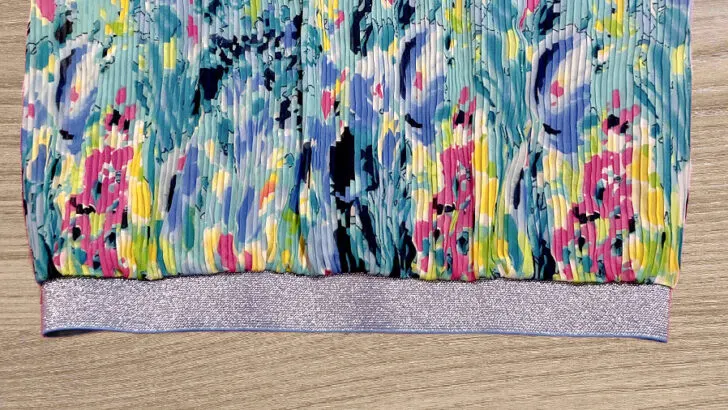In the world of sewing, elastic is an essential component in garment construction that offers a blend of flexibility and support.
When you’re incorporating elasticity to your projects, you have many types of elastic to choose from, each with distinct properties and uses. Understanding the differences between them is important for ensuring the functionality and aesthetics of your finished piece match your vision.

Materials and Composition
Natural Elastic
Natural elastic also called Bio elastic is an eco-friendly alternative to conventional synthetic elastics and is known for being 100% biodegradable. This type of elastic is often made with organic cotton and natural rubber.
Note: Some of the links on this page are affiliate links. This means I will receive a commission if you order a product through one of my links. I only recommend products I believe in and use myself.
The organic cotton is typically certified by standards such as the Global Organic Textile Standard (GOTS), so it is grown without the use of toxic pesticides and synthetic fertilizers. The rubber is sourced from rubber trees and is free from synthetic additives, making the elastic compostable and environmentally friendly.
For example, you can find biodegradable organic elastic made from undyed GOTS Organic Cotton and Natural Rubber, which is a high-quality, compostable, and eco-friendly option for clothing.
Another example includes organic elastic by meter which comprises 60% organic cotton and 40% natural rubber, promoting a plastic-free lifestyle due to its biodegradable properties.
Ideal for delicate hems and cuffs and a wide range of other applications this elastic strikes a balance between flexibility and firmness, feeling gentle against the skin. For eco-conscious sewists who prioritize sustainability, this elastic is a seamless progression in your journey. By pairing it with organic cotton threads and eco-friendly fabrics, you can create clothing that is not only kind to the planet during use but also responsibly returns to the earth after its lifespan.
✅ Related tutorial: Sustainable Sewing: Eco-Friendly Techniques For The Modern Sewist
It’s quite common for us to only discover natural elastic alternatives when we begin exploring more sustainable or organic materials for our projects. Natural elastic, while not as ubiquitous as its synthetic counterpart, is gaining our attention.
Synthetic Elastic
Synthetic elastic is the most widely used type of elastic in various industries. That’s what we used for most of our lives, often without being aware of the existence of natural elastic options.
Synthetic elastic is versatile and durable material commonly used in a variety of applications, from clothing and accessories to sporting goods and medical devices. Unlike natural elastics, synthetic versions are typically made from man-made materials such as polyester, nylon, and spandex (also known as elastane). These materials provide good stretchability and excellent retention properties, so that the elastic returns to its original size and shape after being stretched.
Synthetic elastic may include latex yarns or hypoallergenic alternatives like synthetic polyisoprene or elastane for those with latex sensitivities.
Synthetic elastic often provides a firmer stretch compared to natural elastic. It can be produced in a wide range of colors and widths, catering to specific design needs and preferences.
Due to their synthetic composition, this elastic is not biodegradable. However, it’s highly valued in the textile industry for its consistent performance and ability to withstand repeated use and washing without losing elasticity.
Latex-free Elastic

Latex-free elastic is an alternative for those with latex allergies or sensitivities. It’s made from synthetic materials such as elastane, or other stretchable, latex-free fibers.
It’s used for undergarments, baby clothes, and sportswear where the elastic may come into direct contact with the skin.
Since children’s skin can be more sensitive, latex-free elastic is a safer choice for kids’ clothing and accessories to minimize the risk of allergic reactions.
Latex-free elastic offers the necessary stretch and durability for activewear and swimwear, and it holds up well against sweat, chlorine, and saltwater, which can degrade latex over time.

Soft Elastic Cord from Spandex Elastic Nylon
Blended Materials
Blended materials in elastic combine the properties of both natural and synthetic fibers to create a product that has the benefits of each component. These blends often involve a mix of natural rubber or cotton with synthetic fibers like polyester, nylon, or spandex. The goal of such a blend is to achieve an optimal balance of comfort, durability, stretch, and recovery.
Blended elastic materials provide a middle ground in terms of environmental impact. While not as sustainable as 100% natural elastic, they may reduce the proportion of synthetic materials used, which can be a step towards a more eco-friendly product.
For example, this elastic is made from natural rubber and polyester.

1/4 Flat Elastic Cord Stretch Strap
Design and Patterns
When selecting elastic, the design and pattern directly affect the aesthetic and functionality of your project. Let’s explore the variety of designs available.
Solid Colors
I’ve noticed a remarkable change in the world of solid color elastic. Today, I can find them in so many colors. The options are practically endless, from vivid brights to soft pastels and classic neutrals.
It’s a stark contrast to even 20 years ago. Back then, my choices were much more limited. I remember mostly seeing black, white, and beige. Those were the go-to colors for most of my projects.
The shift over the years has been impressive. It’s clear that dyeing technology has advanced, and there’s a higher demand for personalized touches in design. I appreciate that manufacturers have kept up, expanding their color ranges to meet our creative needs.
Now, when I need elastic, I’m greeted with a rainbow of possibilities. It’s a reflection of how much the industry and our preferences have evolved, and it certainly boosts my creativity.
Just take a look at the Mandala Crafts store on Amazon, and it is quite impressive to see the array of different colors they have for elastic ribbons.
Printed Elastic
Printed elastic opens up a world of decorative possibilities. These elastic ribbons often feature repeated patterns or thematic imagery suitable for holiday crafts, branded packaging, or fashion accents. The printed designs on elastic can truly transform a simple elastic band into a standout feature.
Textured Elastic Ribbons
Textured elastic ribbons are designed with raised patterns or ribbing. The texture not only contributes to the visual appeal but can also provide a non-slip surface, beneficial for hair ties and headbands.

2-inch Wide Colorful Striped Jacquard Elastic Bands
Width and Thickness
Elastic ribbons come in a multitude of widths and thicknesses to accommodate a wide range of applications and preferences.
The width of elastic ribbons can vary significantly, from very narrow options as slim as 1/8 inch or even less, ideal for delicate projects or lightweight garments, to much wider choices that may be several inches across, suitable for waistbands or heavy-duty use.
Thickness is another variable that can impact the functionality and aesthetic of elastic ribbons. You can choose thinner elastics for projects that require a delicate grip. Thicker elastics provide a stronger, more substantial grip for items that require more support.
The choice of width and thickness will depend on the specific requirements of the project at hand, such as the weight of the fabric, the amount of stretch needed, and whether the elastic will be a visible design element or hidden within a seam.
Narrow Elastic
Narrow elastic is commonly used in applications where we need a subtle stretch without adding bulk or drawing attention. This type of elastic is ideal for lightweight fabrics or small-scale projects.
I often use it for creating shirring on garments, securing underwear and pajamas, or as a component in kid’s wear where only a gentle hold is necessary. It’s also perfect for making hair accessories. The narrow width allows it to be easily concealed within seams or casings, maintaining the aesthetic of the finished product while providing the necessary functionality.
Wide Elastic
I often use wide elastic for projects that demand a strong, durable hold. It’s my go-to choice for waistbands in skirts because it provides a comfortable fit while supporting the fabric’s weight. I find that wide elastic is also less likely to twist or roll inside casings, which is why I prefer it for items like waistbands.
I’ve put together a tutorial on sewing skirts with elastic waistbands that takes advantage of wide elastic stability and comfort. For those interested in learning how to create a skirt that fits well without the hassle of a zipper or buttons, you can check out my step-by-step guide How to Sew a Skirt with an Elastic Waistband.
Stretch and Recovery
When selecting elastic for sewing projects, understanding Stretch and Recovery is essential. These two properties determine how the elastic behaves when pulled and how well it returns to its original shape.
Stretch is the measure of how far the elastic can extend. If an elastic has a 100% stretch, this means it can stretch to double its original length. So, if you start with 1 inch of elastic, it can be stretched to 2 inches in total. An elastic with 130% stretch can extend to 2.3 times its original length. That means if you take 1 inch of elastic, you can stretch it out to 2.3 inches.
In both cases, the percentage tells you how much longer the elastic will be when it’s stretched compared to its unstretched, original length.
For example, this natural elastic (from Etsy) has 130% stretch
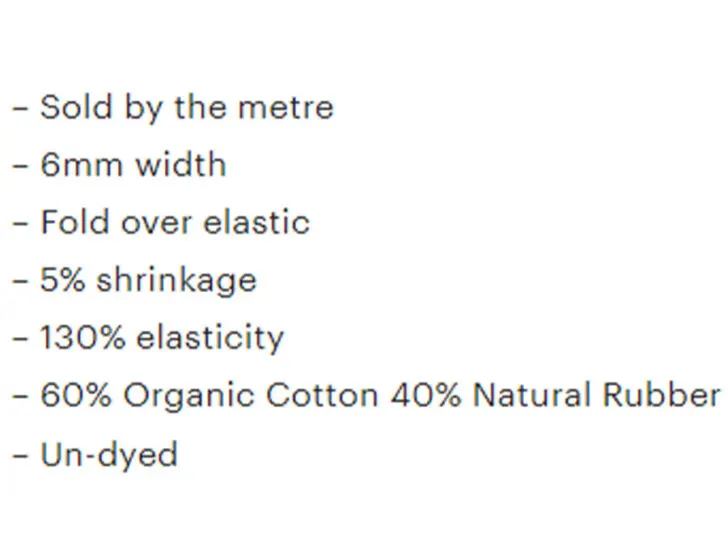
Recovery is just as important, as it indicates the elastic’s ability to return to its original length after being stretched. High-quality elastic should have excellent recovery to prevent garments from becoming baggy over time.
Not every seller provides detailed information on the stretch and recovery properties of their elastic, which can be a challenge. The quality of elastic can vary greatly. Be cautious when purchasing from places like dollar stores, as their products may not meet the standards required for your sewing needs. Poor quality elastic may not stretch or recover as expected, leading to a less durable and ill-fitting final product.
Braided Elastic
When selecting elastic for your sewing projects, you’ll likely encounter braided elastic. Recognized by its longitudinal, parallel ridges, braided elastic narrows when stretched and returns to its original width once the tension is released. Typically, you’ll find it in the casings of sleeves, necklines, and waistbands where a firm grip is desired.
Characteristics:
- Narrows when stretched
- High stretchability
- Easily inserted into casings
Composition:
- Usually made of a blend of rubber and polyester or cotton
Best Uses:
- Lightweight fabrics
- Applications requiring consistent tension
- Avoid using braided elastic for heavier fabrics or instances where it will be directly sewn onto the material, as this can cause loss of stretch and create a puckered appearance.
Clear Elastic
When working on delicate sewing projects, you may often encounter clear elastic ribbon. This type of elastic is noted for its transparency.
What makes clear elastic particularly useful is its ability to provide stretch without influencing the visual design of your fabric. This is why you’ll find clear elastic frequently utilized in areas that demand a near-invisible support, such as in lingerie or swimwear. When sewn into lightweight or medium-weight fabrics, it maintains the original aesthetics while offering the needed elastic property.
Features of Clear Elastic:
- Transparency: Integrates seamlessly into fabrics.
- Stretchability: Offers a comfortable, snug fit without being visible.
- Lightweight: Suitable without adding extra weight or bulk to garments.
This type of elastic is usually made of polyurethane, which contributes to its clear appearance. Handle it with care as it is more delicate than other types of elastic. When sewing with clear elastic, be mindful of the tension to prevent puckering in the fabric.
Here are some common uses for clear elastic:
- Shoulder seams in knitwear to prevent stretching.
- Hems where elastic gathering is needed without visibility.
- Inside swimsuits for secure, but discrete, flexibility.
Buttonhole Elastic
Buttonhole elastic offers a unique combination of flexibility and adjustability. Designed with evenly spaced buttonholes, this type of elastic allows you to easily customize the fit of your garments. You’ll often find it in the waistbands of children’s clothing, maternity wear, or any garment that may require size adjustments over time.
Here’s what you need to know about buttonhole elastic ribbon:
- Material Composition: Buttonhole elastic is typically made from a blend of natural and synthetic fibers that provide both stretchiness and durability.
- Widths Available: It’s common to come across widths ranging from 1/2 inch to 1 inch, but sizes can vary according to the intended use of the elastic.
- Adjustable Fit: The key feature is the pre-made buttonholes, which are usually evenly spaced. This allows you to adjust the tightness of a garment by attaching a button to the appropriate hole.
Choose buttonhole elastic for projects where future adjustments might be necessary.
Fold-Over Elastic
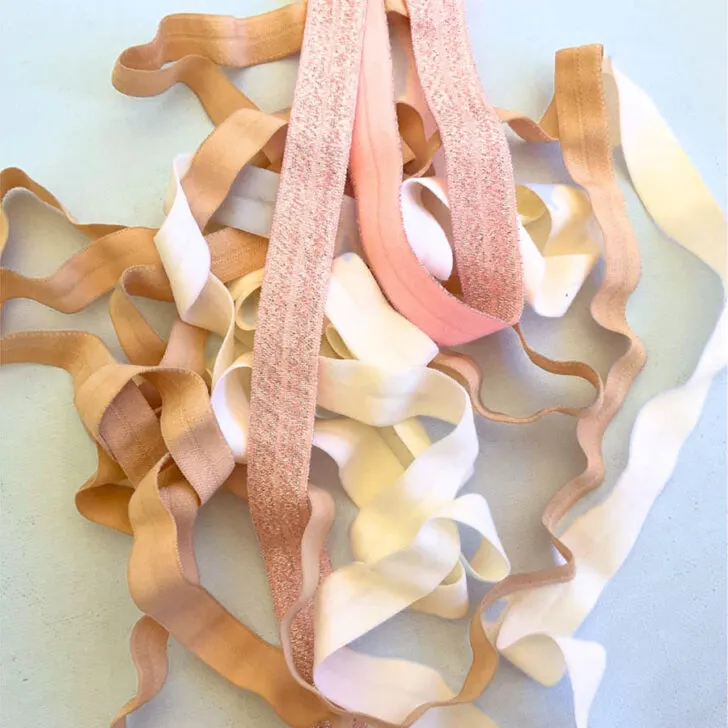
Fold-over elastic, commonly known as FOE, is designed with a center crease that allows you to easily wrap it over fabric edges, creating a clean finish on items like apparel hems, hair ties, headbands, etc.
Characteristics:
- Width: Typically 5/8 inches, but varies.
- Texture: Smooth on one side with a slight sheen; matte on the other side.
- Stretch: Offers good elasticity, essential for items that require movement.
Advantages:
- Gentle on skin: The soft texture of FOE is ideal for items that come into direct contact with the skin.
- No rolling: The center crease discourages the elastic from rolling, keeping it flat against the body.
- Aesthetic appeal: With a variety of colors and patterns available, FOE adds decorative details while being functional.
Non-Roll Elastic
For projects that demand a sturdy and reliable hold such as waistbands or heavy garments, you’ll find non-roll elastic to be your go-to option. Distinguished by its horizontal ribs, this type of elastic ensures that your creations maintain their shape without twisting or rolling when stretched.

Dritz 9405W Non-Roll Woven Elastic
Features
- Horizontal Ribs: Provides extra stability.
- Widths: Ranges from 1/2 inch to 3 inches.
- Material: Typically a blend of polyester and rubber.
Uses
- Waistbands: Ideal for skirts and pants.
- Heavy Fabrics: Suitable for bulky materials.
- Casings: Easily threaded through casings without losing form.
When you’re sewing with non-roll elastic, consider the weight of the fabric. Heavier fabrics pair well with the robust structure of this elastic.
Decorative Elastic
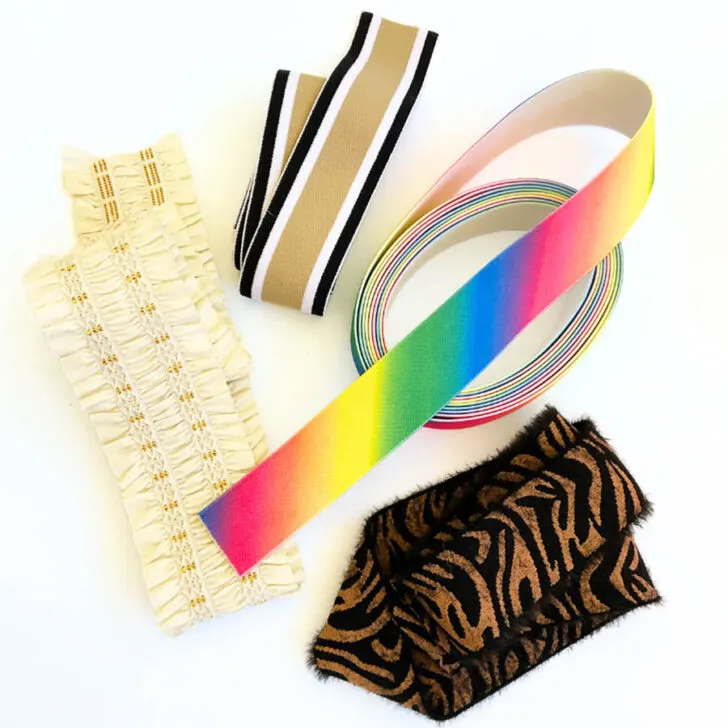
This special kind of elastic is not only functional but also serves as an ornamental feature. It can be found in a variety of colors, patterns, and finishes, making it a great option for a wide range of applications.
Types of Decorative Elastic Ribbon:
- Glitter Elastic
- Satin Elastic
- Ruffle Elastic
- Organdy Elastic
- Picot edge Elastic
- Sequin Elastic

1 Inch Silver Sequin Elastic Trim
You’ll often see decorative elastics used in areas where the elastic is visible, such as on the waistbands of skirts or as headbands. Its ability to stretch makes it practical, while the decorative aspect enhances the garment’s or item’s overall appearance.
For instance, Silver Glitter Elastic could be the ideal choice for adding some shine to party dress, while this Organza Ruffled elastic might be used for a decorative finish on lingerie or sleepwear.
Remember to select both the style and the type that will hold up to the intended use and care. Elastic ribbon for swimwear, for example, needs to withstand chlorine and saltwater, whereas elastic for a dress may prioritize appearance and comfort. Always consider the end use of your project when choosing your decorative elastic ribbon.
Are You Using The Right Elastic For Your Sewing Project?
Are you using the right elastic for your sewing project? It’s a question that can make or break the fit and function of your handmade items. Selecting the appropriate elastic is more complex than just grabbing any stretchy strip. There are many types, each with unique properties and specific uses. From waistbands that won’t stay put to lingerie that’s lost its shape, the wrong choice can lead to common and frustrating sewing mistakes. Here are a few of them.
- Lack of Durability: The wrong elastic might not withstand the stress and strain of regular use and multiple washings, leading to early wear and tear or even breakage.
- Inadequate Support: For example, using a lightweight elastic in a heavy waistband can result in a waistband that rolls, twists, or simply does not provide enough grip, causing the garment to slip or sag.
- Uncomfortable Fit: An elastic that’s too firm for lingerie or children’s wear can be restrictive and uncomfortable, while too soft an elastic may not hold the garment in place properly.
- Compromised Aesthetics: Using a visible elastic that’s too bulky or textured for a project can detract from the finished look of a garment. An elastic that’s too thin may not provide a clean, finished appearance where it is needed.
- Incorrect Recovery: If the elastic doesn’t snap back to its original size after being stretched, it can lead to a garment that becomes out of shape. For example, using a braided elastic (which has good recovery when not pierced) in a casing where it is sewn directly to the fabric can cause it to lose its recovery ability.
- Stretch Limitations: Some elastics have a higher stretch capacity than others. Choosing one with insufficient stretch for activewear, for instance, can restrict movement and make the garment uncomfortable to wear.
To avoid these mistakes, always match the type of elastic to the specific needs of your project for the best results.
Did you find this guide helpful? If so, save this pin (see below) on your sewing board on Pinterest so you can come to the article later when you need this information on types of elastic , and follow me on Pinterest for more tips, tutorials, and inspiration!
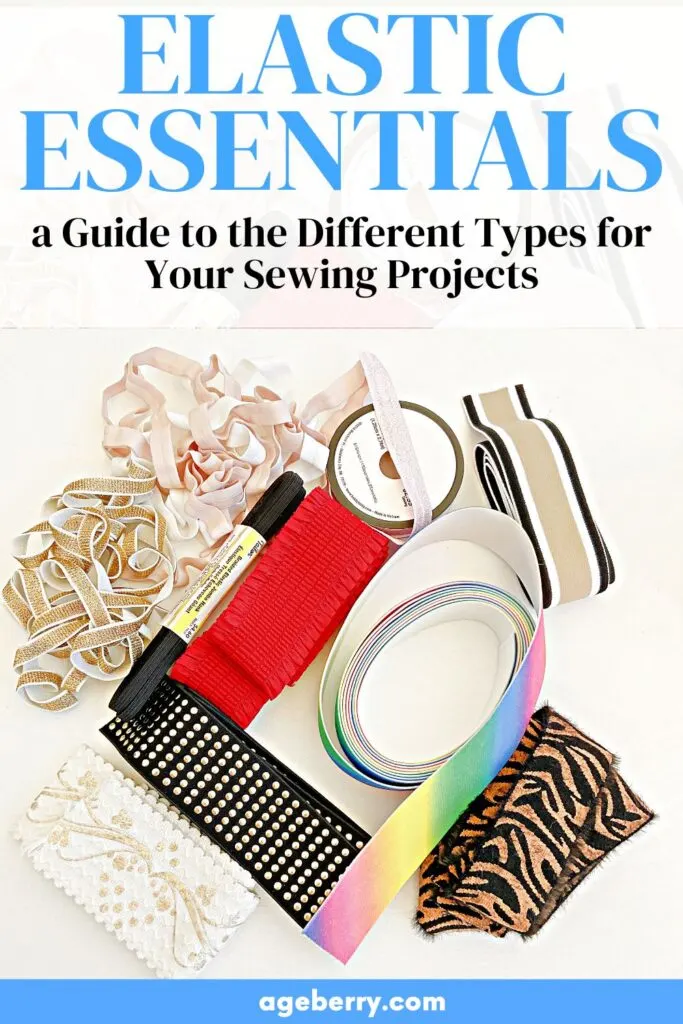
latest posts
- Knot a Problem: Easy Ways to Secure Short Thread Ends
- Ever Tried This on Your Serger? This Differential Feed Feature Will Amaze You
- Ditch My Sewing Machine? Not in This Lifetime!
- Adorable DIY Needle Book | Easy Tutorial for Beginners
- Master the Seam Ripper: Your Ultimate Guide to Precision Stitch Removal
- Think You Know Zippers? This Installation Guide Might Surprise You
- Why Does Your Seam Ripper Have a Red Ball? Discover Its Purpose!
- Topstitching Troubles? This Simple Trick Will Turn It Around Instantly!
- How to Sew Shirring: A Step-by-Step Guide to Elastic Thread Gathering





